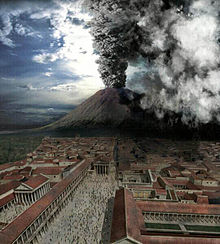http://www.eyewitnesshistory.com/pompeii.htm
http://curiosity.discovery.com/question/where-is-pompeii-located.
http://home.comcast.net/~apollophotos/photos/italy/pompeii/
http://archaeology.about.com/od/pter,s/q/pompeii.htm
http://wiki.answers.com/Q/How_did_Pompeii_happen
http://www.rphs.evisland.net/toms/parents.htm
http://www.east-buc.k12.ia.us/00_01/fp/pom/pom.htm
The History of Pompeii
The Last Day

This is what Archioligists think the volcano and the town looked like the last day.
Friday, December 7, 2012
Post 5 ~more interesting facts~
~interesting facts~
Pompeii is an ancient city in Italy. When the volcano, Mt. Vesuvius,
erupted, the ashes mixed with rain, to form molds that would cover the bodies of
the people that died when the volcano erupted. The city was left in ruins and
uncovered for 1500 years after the volcanic eruption in the year AD 79.
Pompeii is famous for a volcano named Mt. Vesuvius. The eruptions of Mt.
Vesuvius took the lives of many people that lived in Pompeii during the year AD
79.
The absolute location of Pompeii is 41 degrees North, and 15 degrees East of the
equator.
Thursday, December 6, 2012
post 4 ~why i chose it?~
Why did I choose Pompeii as my topic?
I chose pompeii as my topic for this final project, because pompeii and volcanos have always fasinated me. They are very interesting and fun to learn about. I enjoy seeing how people live back in ancient Rome and how it was peterfied and preserved whhen Vesuviusblew its top. Its mysterious to wonder how bad the erutpion aactually was compared to what historians and archiologists say today. I aslo chose this as my topic because i thought you all might like to learn a little more as well.
I chose pompeii as my topic for this final project, because pompeii and volcanos have always fasinated me. They are very interesting and fun to learn about. I enjoy seeing how people live back in ancient Rome and how it was peterfied and preserved whhen Vesuviusblew its top. Its mysterious to wonder how bad the erutpion aactually was compared to what historians and archiologists say today. I aslo chose this as my topic because i thought you all might like to learn a little more as well.
Wednesday, December 5, 2012
post 3~interesting facts~
Interesting facts about pompeii:
Pompeii was originally a Greek city, though with the decline of the Greek empire and the rise of the Roman Empire, Pompeii was assimilated by the Romans, adopting many of the customs of the Roman people but at the same time retaining much of its Greek heritage.Pompeii was an important port, south of Naples it was a major stop on the sea route to Rome from Africa. It most likely connected to a road across the "boot" to modern Brendisi connecting the east and west coasts together. Pompeii was a well to do city.The inhabitants of Pompeii did not know that Vesuvius was a volcano, as it hadn’t erupted in 1,800 years. There isn’t even a Latin word for volcano.
Pompeii was originally a Greek city, though with the decline of the Greek empire and the rise of the Roman Empire, Pompeii was assimilated by the Romans, adopting many of the customs of the Roman people but at the same time retaining much of its Greek heritage.Pompeii was an important port, south of Naples it was a major stop on the sea route to Rome from Africa. It most likely connected to a road across the "boot" to modern Brendisi connecting the east and west coasts together. Pompeii was a well to do city.The inhabitants of Pompeii did not know that Vesuvius was a volcano, as it hadn’t erupted in 1,800 years. There isn’t even a Latin word for volcano.
Tuesday, December 4, 2012
Post 2
More interesting facts about Pompeii!
The eruption of AD 79 was very unusual, without lava or other characteristics normally associated with volcanoes. It was a Plinian eruption – the most dangerous and feared kind of all – involving super-heated gas, magma and ash that form a giant towering column that builds up into the sky. The magma cools and falls to the earth as pumice. Vesuvius erupts in this way once in every 2,000 years.
The eruption of AD 79 was very unusual, without lava or other characteristics normally associated with volcanoes. It was a Plinian eruption – the most dangerous and feared kind of all – involving super-heated gas, magma and ash that form a giant towering column that builds up into the sky. The magma cools and falls to the earth as pumice. Vesuvius erupts in this way once in every 2,000 years.
post 1 ~the esential~
When: The natural distaster of Pompeii, occured on August 24th, 7 9 A.D.
Where: Pompeii was a Roman city located a few miles southeast of Naples at the base of Mt. Vesuvius
What: Pompeii was destroyed by a volcanic eruption in 79 AD:
How/Why:Mt Vesuvius erupted and Pompeii was living in its shadow. The town was covered in many metres of volcanic debris and hidden from sight for hundreds of years, only to be found once again in the 17th century. A reservoir of boiling magma some three kilometers wide formed within Vesuvius, trapped inside by a plug of old magma. A chemical reaction involving water and gases finally shattered the lava plug and Vesuvius roared back to life.From beginning to end, the eruption took just under 24 hours.
Where: Pompeii was a Roman city located a few miles southeast of Naples at the base of Mt. Vesuvius
What: Pompeii was destroyed by a volcanic eruption in 79 AD:
How/Why:Mt Vesuvius erupted and Pompeii was living in its shadow. The town was covered in many metres of volcanic debris and hidden from sight for hundreds of years, only to be found once again in the 17th century. A reservoir of boiling magma some three kilometers wide formed within Vesuvius, trapped inside by a plug of old magma. A chemical reaction involving water and gases finally shattered the lava plug and Vesuvius roared back to life.From beginning to end, the eruption took just under 24 hours.
Subscribe to:
Posts (Atom)